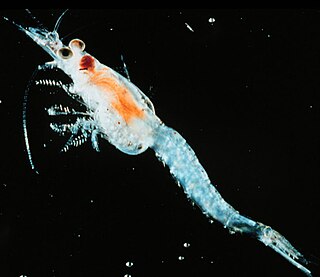
Brackish water, sometimes termed brack water, is water occurring in a natural environment that has more salinity than freshwater, but not as much as seawater. It may result from mixing seawater and fresh water together, as in estuaries, or it may occur in brackish fossil aquifers. The word comes from the Middle Dutch root brak. Certain human activities can produce brackish water, in particular civil engineering projects such as dikes and the flooding of coastal marshland to produce brackish water pools for freshwater prawn farming. Brackish water is also the primary waste product of the salinity gradient power process. Because brackish water is hostile to the growth of most terrestrial plant species, without appropriate management it is damaging to the environment.

Branchiopoda is a class of crustaceans. It comprises fairy shrimp, clam shrimp, Diplostraca, Notostraca and the Devonian Lepidocaris. They are mostly small, freshwater animals that feed on plankton and detritus.

Mysida is an order of small, shrimp-like crustaceans in the malacostracan superorder Peracarida. Their common name opossum shrimps stems from the presence of a brood pouch or "marsupium" in females. The fact that the larvae are reared in this pouch and are not free-swimming characterises the order. The mysid's head bears a pair of stalked eyes and two pairs of antennae. The thorax consists of eight segments each bearing branching limbs, the whole concealed beneath a protective carapace and the abdomen has six segments and usually further small limbs.

Prof Georg Ossian Sars HFRSE was a Norwegian marine and freshwater biologist.

The bloody-red mysid, Hemimysis anomala, is a shrimp-like crustacean in the Mysida order, native to the Ponto-Caspian region, which has been spreading across Europe since the 1950s. In 2006, it was discovered to have invaded the North American Great Lakes.

Neomysis integer is a species of opossum shrimp found in shallow marine bays and estuaries of Europe, with a transparent greenish or brownish body and a large cephalothorax. It is found in very shallow water in both high and low-salinity habitats. It is a filter feeder and the female broods her eggs in a brood pouch beneath her cephalothorax.

The Diplostraca or Cladocera, commonly known as water fleas, are a superorder of small crustaceans that feed on microscopic chunks of organic matter.

Paramysis is a genus of mysid crustaceans (Mysidacea) in family Mysidae, distributed in coastal zone of low boreal East Atlantic Ocean, Mediterranean Sea and the basins of Black Sea, Sea of Azov and Caspian Sea.

Mysis relicta is a shrimp-like crustacean in the Mysida order, native to lakes of Northern Europe and to the brackish Baltic Sea.

Mysis diluviana is a mysid crustacean found in freshwater lakes of northern North America.

Paramysis baeri is a species of mysid crustacean from the genus Paramysis, named in honour of the prominent biologist Karl Ernst von Baer. Its body is 13–31 millimetres (0.51–1.22 in) long, and it is only found in the coastal waters of the Caspian Sea, on sandy and muddy bottoms, at depths of less than 20 m (66 ft). For over a century, it was thought to be distributed throughout the whole Ponto-Caspian basin, but recently the range was reconsidered after the rediscovery and re-establishment of the closely related species Paramysis bakuensis. Since the taxonomical status of P. baeri has been reconsidered, the distribution and ecology of the species remains poorly known. Paramysis baeri can be distinguished from P. bakuensis and other species of the subgenus Paramysis s. str. by the rather broad, almost quadrangular exopod of maxilla 2, the strongly serrated paradactylar claw-setae of pereiopod 6, and other features.
Paramysis bakuensis is a species of mysid crustacean from the family Mysidae, named by the locality from where it was originally described, the town of Baku in Azerbaijan by the Caspian Sea.

Platycopiidae is a family of copepods. Until the description of Nanocopia in 1988, it contained the single genus Platycopia. It now contains four genera, three of which are monotypic; the exception is Platycopia, with 8 species.
Mysis salemaai is a shrimp-like crustacean in the Mysida order, inhabiting lakes of Ireland and South Scandinavia and brackish waters of the northern Baltic Sea.

Nikolai Mikhailovich Knipovich was a Russian and Soviet ichthyologist, marine zoologist and oceanographer, notable as the founder of fisheries research in the Russian North.

Gastrosaccus spinifer is a shrimp-like crustacean in the order Mysida, the opossum shrimps, native to the eastern Atlantic Ocean and the coasts of Northern and Western Europe.
Siriella is a genus of mysid crustaceans form the family Mysidae, consisting of approximately 90 species. Found in all seas except cold Arctic and Antarctic waters, the genus is most diverse in tropics.

Heteromysis is a genus of marine mysid crustaceans from the family Mysidae, associated with various shallow-water invertebrates. The name describes differentiation of its pereiopods as possible adaptation to commensal life-style. Heteromysis is one of the largest mysid genera, containing more than 100 species. The genus is distributed globally, but predominantly in tropical and subtropical waters.
Paramysis intermedia is a species of shrimp in the family Mysidae. Its natural distribution is Ponto-Caspian, but it is also invasive species, e.g. on the Baltic coast of Estonia. It tolerates salinities between 0–12 ppt; it occurs in estuaries but does not penetrate very deep into rivers.
Iphigenellidae is a freshwater family of amphipods in the superfamily Gammaroidea. It is found in the Ponto-Caspian region, which encompasses the Black, Azov, and Caspian Seas.















